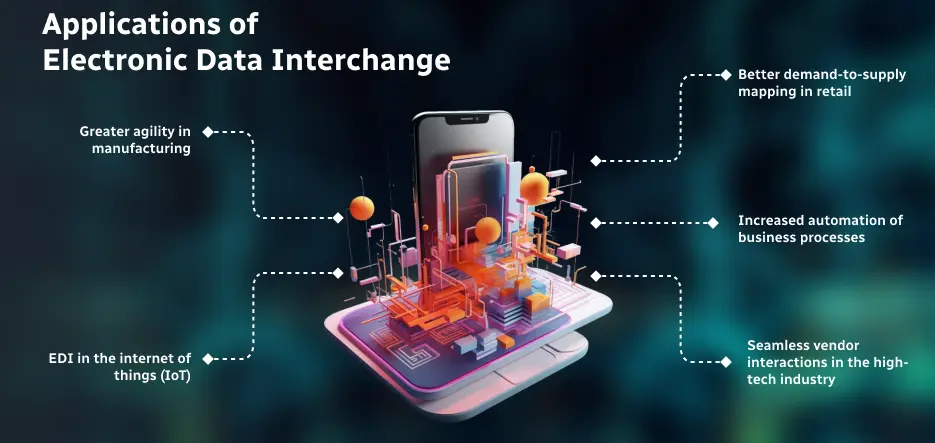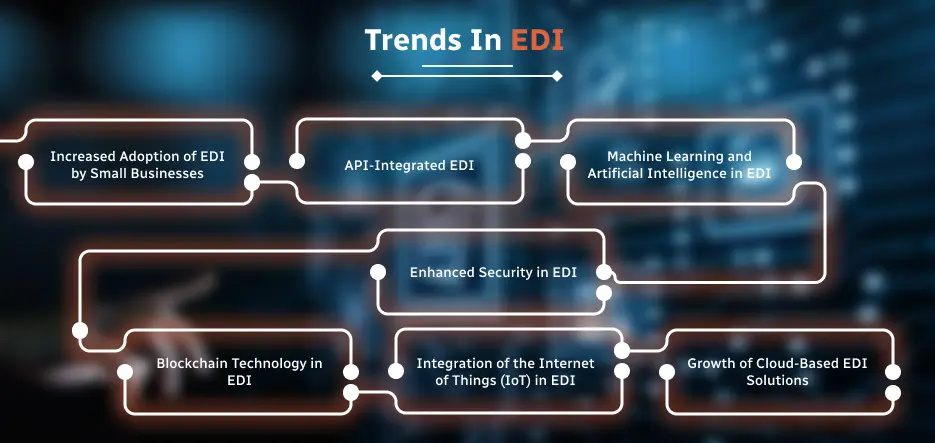Table of Contents
Cloud EDI is transforming the way businesses exchange data electronically. In a traditional EDI setup, businesses install on-premise software to connect and share electronic documents with their partners. However, with cloud-based EDI solutions, the EDI platform is hosted on the cloud and accessed over the internet. This has many benefits like lower costs, easy setup and maintenance, automatic updates, and scalability.
By moving EDI to the cloud, businesses can accelerate document exchange, get real-time visibility into partner data, and improve supply chain efficiency. Implementing cloud EDI involves simply subscribing to an EDI service provider, connecting partners, and starting to exchange EDI documents. The service provider takes care of the infrastructure, maintenance, and security of the EDI platform. This gives businesses the freedom to focus on their core operations while leveraging the latest technologies for EDI.
A brief explanation of EDI (Electronic Data Interchange)
EDI stands for Electronic Data Interchange, which is a method of electronically exchanging business documents between computers using a standardized format. It eliminates the need for paper documents like purchase orders, invoices, shipping notices, and payment files by transferring this information between organizations in an electronic, automated way.
EDI uses EDI standards that define sets of formatted EDI messages. These standards specify data elements within transaction sets as well as transaction types and codes that recipients can interpret. The two main EDI standards are X12 and EDIFACT, with multiple versions for different industries and purposes.
Businesses implement EDI to streamline document-based processes and gain efficiency. Using EDI, organizations can place orders, receive shipments, submit invoices, process payments and perform other transactions with business partners quickly and automatically. As a result, it saves time, reduces manual errors, cuts costs, and improves cash flow.
Get the Cloud EDI solutions tailored to your business needs
Overview of traditional EDI
Traditional EDI refers to the earliest form of Electronic Data Interchange, which relied on Value Added Network (VAN) providers as intermediaries between trading partners. With traditional EDI, businesses would connect to a VAN that maintained a central mailbox and routing directory. When one business sent an EDI document, the VAN would receive it, identify the intended recipient based on embedded routing information, and forward the document to that trading partner’s VAN mailbox.
Then, the recipient would retrieve the document from their VAN mailbox. While able to automate the exchange of common business documents, traditional EDI required the overhead of VAN providers as intermediaries and maintaining direct connections between each trading partner’s internal systems and the VAN.

Limitations of on-premises EDI systems
On-premises EDI solutions refer to systems that are installed and run within a business’s internal IT infrastructure. While these types of EDI setups were once the norm, they have several drawbacks compared to newer cloud-based options:
- Costly to maintain: On-premises EDI systems require IT resources to implement, configure, upgrade, and manage over time. This ongoing maintenance adds to operating expenses and IT workload.
- Difficult to scale: Expanding an on-premises EDI system to support more trading partners or greater volumes of transactions often requires costly hardware upgrades and additional EDI support services. This lack of scalability limits growth potential.
- Inflexible and slow to change: Making changes to on-premises EDI systems typically requires extensive testing and reworking of internal interfaces. These disruptions make it difficult to quickly adapt solutions to changing business needs.
- Lack of mobility and accessibility: On-premises EDI solutions tend to be confined within a business’s internal network, limiting the ability for remote or mobile access that cloud-based options provide.
- Integration challenges: Integrating on-premises EDI systems with other internal applications and external systems often requires extensive custom coding and manual effort.
- Security issues: Ensuring the security of on-premises EDI systems requires constant monitoring, patching, and updates – which many businesses fail to do adequately over time.
The emergence of cloud-based solutions
EDI systems have long been the norm, but they come with many limitations, like high costs, lack of scalability, inflexibility, and security issues. In recent years, cloud-based EDI solutions have emerged as a viable alternative with several advantages:
- Lower upfront and ongoing costs – Cloud-based EDI Solution Providers handle implementation, upgrades, scaling, and ongoing maintenance, saving businesses expensive IT resources and hardware. Customers typically pay a monthly or annual subscription fee.
- Easy scalability – Since EDI infrastructure is managed by Electronic Data Interchange Providers, expanding systems to support growth requires no additional hardware or IT investments. Solutions simply scale on demand within the cloud.
- Flexibility and agility – Cloud-based EDI systems are far easier and faster to modify, reconfigure and enhance due to their software-based nature. This responsiveness enables businesses to adapt quickly to changing needs.
- Access from anywhere – With solutions hosted in the cloud, EDI systems can be accessed remotely from any internet connection. This improves mobility and allows trading partners to collaborate easily.
- Integrations simplified – Cloud Electronic Data Interchange Providers integrate cloud EDI systems with various applications through APIs, eliminating the need for complex, expensive custom coding for on-premises integrations.
- Enhanced security – EDI Solution Providers have dedicated EDI support teams for security, processes, and technologies to keep solutions safe. They can apply patches and updates instantly across their entire infrastructure.
Cloud-based EDI solutions have emerged to address many of the limitations of traditional on-premises implementations. Their numerous advantages around costs, scalability, flexibility, accessibility, integration, and security have made this an appealing option – and in many cases, a superior one – for businesses seeking to maximize the value of EDI Services.
Key features of Cloud EDI
Here are the key features of cloud-based EDI solutions:
- Scalability: Since cloud EDI consulting infrastructure is managed by providers, expanding systems to support growth requires no additional hardware or IT investments. Solutions simply scale on demand within the cloud. This enhances agility and the ability to adapt to changing needs.
- Flexibility: Cloud EDI systems are software-based and easily modifiable through simple configuration changes. This responsiveness allows businesses to quickly react to new requirements, document types, or trading partners.
- Ease of access: EDI solutions can be accessed from any internet connection, improving mobility and convenience for users. Trading partners can collaborate more easily due to this 24/7 accessibility.
- Simplified integration: Cloud EDI Service Providers in the USA expose APIs that simplify integrating cloud solutions with various applications. This avoids complex, costly custom coding typically needed for on-premises integrations.
- Enhanced security: Cloud-based EDI providers have dedicated security teams, processes, and technologies that automatically apply patches and updates across their entire infrastructure. Security tends to be more robust than what most businesses can achieve on their own.
- Automation and AI capabilities: Many EDI Solution Providers offer features like machine learning, robotic process automation, and data validation tools that reduce manual work, catch errors, and improve efficiency.
- Professional Cloud EDI services: Leading cloud EDI vendors provide consulting, implementation, custom mapping, support, and training for Cloud EDI services to maximize value for customers.
Comparison of Cloud EDI with traditional on-premises EDI
Here is a comparison of cloud EDI and traditional on-premises EDI:
- Costs: Cloud EDI Services are typically more cost-effective due to low, monthly subscription fees and no major upfront costs. On-premises EDI requires expensive hardware, software licenses, and ongoing IT resources for maintenance.
- Scalability: Cloud EDI easily scales on demand within cloud infrastructure managed by EDI Service Providers in the USA, while on-premises EDI often requires hardware upgrades and additional IT support to scale, limiting growth potential.
- Flexibility: Where cloud EDI systems are software-based and quickly modifiable, on-premises EDI solutions are difficult and disruptive to change due to extensive internal interfaces.
- Accessibility: Cloud EDI can be accessed from anywhere with an Internet connection whereas,on-premises EDI is confined within organizations’ internal networks.
- Integration: Cloud EDI leverages APIs for simpler integrations with applications but on-premises EDI often requires complex custom coding for integrations.
- Functionality: Cloud EDI offerings typically include automation, AI, and professional EDI services. On the other hand, on-premises EDI focuses on basic document exchange.
- Adoption: Cloud EDI adoption is growing due to advantages over on-premises options. However, some organizations prefer having EDI systems fully within their control.
Enhanced Efficiency with Cloud EDI
Here are the ways cloud EDI enhances efficiency:
- Faster deployments – Cloud EDI implementations are faster and easier since providers handle setup, deployment, upgrades, and ongoing management of systems. There is a requirement of fewer IT resources.
- Scalability – Cloud EDI scales on demand within EDI Software Providers‘ infrastructure. There are no limits to growth like with on-premises solutions that require costly, lengthy hardware upgrades. This enhances agility.
- Flexibility – Cloud EDI is designed to be quickly and easily configurable to adapt to changing business needs. Modifications often simply require flipping a switch, versus disruptive changes for on-premises solutions.
- Availability – Cloud EDI’s software-based infrastructure ensures high system uptime and reliability. EDI Software Providers have redundancy measures in place to minimize disruptions.
- Simplified integrations – Cloud providers expose APIs that simplify integrating Cloud EDI solutions with various applications. This streamlines processes and enhances information flow.
- Automation capabilities – Many cloud EDI vendors offer features like AI, machine learning, and RPA to automate routine tasks, detect errors, validate data, and improve accuracy – boosting efficiency.
Integration with Existing Systems
Successful integration of cloud EDI consulting requires compatibility with a business’s internal applications and systems at both technical and data levels. This ensures the accurate exchange and processing of electronic documents. Physical connections and communication protocols like APIs, FTP, or EDIINT must be established between the cloud platform and internal systems.
Testing
Thorough testing in a duplicate environment is critical before going live to identify and resolve issues impacting transactions or data quality. Data elements within EDI Services documents must be accurately mapped to corresponding fields in internal systems to ensure proper routing of information. Make proper communication of any system changes to the cloud provider to avoid integration issues. There is a need for ongoing monitoring of integrations using dashboards and reports to identify and fix errors or downtime.
The integration enables automated transactions that streamline processes by saving manual effort. Strong security measures are required where integrations expose internal systems externally. The cloud EDI solution is upgraded frequently, requiring consistent updates internally to maintain compatibility over time. Cloud EDI services can minimize issues and maximize ROI from integrations. With the right planning, testing, and management, integrations of Cloud EDI solutions can unlock their full potential for streamlining business processes. It can help in optimizing information flows between organizations and trading partners.
Unlock the full potential of streamlining business processes with our Cloud EDI Services
Security and Compliance Considerations
Secure data transfer is critical as the business information within EDI documents is sensitive. Leading cloud EDI Software Providers employ robust encryption methods for data in transit between organizations and their infrastructure. Storage of data at rest within the cloud EDI platform is also secure through encryption and access controls. Strong authentication measures like multifactor authentication and role-based access limitations restrict access to authorized users.
Regular security audits and certifications ensure that cloud EDI consulting meets industry standards. Physical and network security controls within data centers further protect against threats. Cloud EDI consultancy has dedicated security teams that constantly monitor for threats, rapidly apply updates and patches across their infrastructure, and notify customers of any security issues. Role-based permissions in the software limit the functions users can perform. Audit trails and logs record all document exchanges and transactions for compliance purposes.
Cloud-based solutions are often designed to comply with relevant industry and data security regulations. The Cloud EDI services can assist customers in achieving their compliance objectives. Organizations remain responsible for their internal system security, as well as meeting all applicable compliance requirements for the data they exchange and store within the cloud EDI platform. With the right security and compliance measures in place, cloud EDI Services enables organizations to benefit from automated, electronic data interchange while minimizing risks and adhering to necessary policies and regulations.
Implementation Strategies
- Start by establishing clear objectives and key metrics for your cloud EDI initiative. What specific benefits do you hope to achieve in terms of costs, efficiencies, processes, or customer service? Having tangible goals will guide your implementation.
- Create a cross-functional team representing all impacted departments to provide input, identify needs, validate requirements, and champion change. This ensures a holistic approach.
- Conduct a thorough assessment of your current EDI landscape. What systems are involved? What will be the integrations? What document types and trading partners exist? Understanding your starting point is critical.
- Select the right cloud EDI provider for your specific needs. Compare offerings, and evaluate features, pricing, reputation, security, and consulting capabilities. Leave no stone unturned in your research.
- Build a detailed implementation plan and timeline covering all phases from setup to testing to go-live and change management. Address contingencies and opportunities for course correction.
- Establish internal system readiness criteria to ensure compatibility, connectivity, permissions, and data cleanliness before integrating the cloud EDI solution and avoid rushing integrations.
- Partner with your chosen Electronic Data Interchange Consultant to map data, configure the system, set up integrations, develop playbooks, and conduct training. Leverage their expertise fully.
- Thoroughly test your new cloud EDI solution end-to-end with all trading partners before going live. Address all issues that emerge and refine your approach.
By implementing cloud EDI with a well-planned and holistic approach that leverages internal and external expertise, businesses can maximize the value, efficiency, and seamlessness of their transition to a modern EDI solution. The right implementation strategies set the stage for long-term adoption and ongoing optimization.
Looking for Cloud EDI Solutions?
Well, your search ends here. Contact our EDI experts at A3logics
Overcoming Challenges of Cloud EDI
Here are some of the key challenges:
- Resistance to change – Involve impacted teams early, communicate thoroughly, provide training resources, and demonstrate how the new system simplifies workflows to gain buy-in.
- Lack of internal readiness – Take time to cleanse and validate internal data, establish system compatibility, and put required infrastructure in place before rushing integrations. Reduce risks.
- Compatibility issues – Thoroughly test integrations with all trading partners in a duplicate environment to identify and resolve any mismatches in data, documents, or communications.
- The complexity of mappings – Partner with your Electronic Data Interchange Consultant to map data elements accurately. Their experience and best practices will ease the mapping process.
- Trading partner delays – Communicate early and often with partners to align timelines, prepare them for testing, and mitigate holdups that could impact your go-live date.
- Security concerns – Leverage your provider’s enhanced security capabilities and work with their team to meet your specific requirements. Ease nervousness by communicating control measures.
- Lack of internal expertise – Partner closely with your Electronic Data Interchange Consultant to supplement your own team’s abilities. Leverage their consulting, training, and support.
- Process changes – Identify how the new system will impact processes and make adjustments accordingly. Provide end users with workflows, playbooks, and examples to ease them into new routines.
With proper preparation, stakeholder buy-in, expert EDI support services, and an iterative approach that learns from early challenges, organizations can successfully navigate common obstacles to cloud-based EDI implementation and ensure a smooth transition to the benefits of electronic data interchange. Facing hurdles head-on and overcoming them strengthens implementation outcomes.
Future Trends and Innovations
Here are some future trends and innovations expected in cloud-based EDI solutions:

- Automation and artificial intelligence – The use of AI, machine learning, and robotic process automation is poised to grow within EDI platforms to automate more document validation, data extraction, mapping, and other repetitive tasks that burden human workers. This could majorly improve efficiency.
- Blockchain integration – Some experts predict blockchain will be integrated into EDI networks to further enhance security, simplify transactions, and enable real-time visibility and event triggering. However, this remains years away from widespread adoption.
- Internet of Things connectivity – As more physical products become ‘smart’ and Internet-connected, EDI solutions may increasingly transmit data about product use, maintenance needs, and even replenishment requirements automatically between manufacturers and customers.
- Transition to standardized XML – Although established EDI formats like X12 and EDIFACT will continue for years, the migration to XML as a global standard for EDI is expected to accelerate. XML offers flexibility and simplicity.
- Business network expansions – Cloud platforms enabling EDI within digitized business networks of suppliers, distributors, customers, and logistics providers will continue to expand reach, automate more processes, and aggregate more data for improved decision-making.
- Integration with SaaS applications – EDI solutions will increasingly be designed to seamlessly integrate with major cloud-based ERP, CRM, WMS, and other software as a service (SaaS) applications through APIs and partnerships. As a result, this streamlines processes further.
- Hyper automation – The ultimate goal of some cloud EDI consultancy is end-to-end ‘hyper-automation’ of business processes through a system that can fully automate tasks from reception of incoming documents through data extraction, exception handling, archival, and more with minimal human intervention.
While still in the early stages of development, these likely trends – including the growth of AI/automation, blockchain use, IoT connectivity, XML transition, business network expansion, SaaS integration, and hyper-automation – point to an exciting future of greater efficiency, simplicity, security and insight through next-generation cloud-based electronic data interchange solutions.
Conclusion
Cloud EDI consultancy offers businesses numerous advantages compared to traditional on-premises EDI solutions. By leveraging the cloud computing model, cloud EDI enables the secure electronic exchange of information and automation of document-based processes. Companies gain benefits with the help of EDI companies like
- lower costs,
- easier scalability,
- greater flexibility
- accessibility,
- faster integrations,
- stronger security, and
- expanded functionality
When implemented properly through careful planning, internal and external expertise, thorough testing, and change management, cloud EDI significantly enhances efficiency. It addresses the limitations of traditional EDI through factors such as cost savings, faster deployments, easy scalability, flexibility, high availability, simplified integrations, and automation capabilities. Cloud EDI allows organizations to optimize resources, digitally transform manual processes, and maximize the value of securely exchanging essential information electronically and automatically with trading partners.






